Aspiration systems: types, design, installation selection criteria
Production processes are often accompanied by the release of dust-like elements or gases that pollute the indoor air.Aspiration systems designed and installed in accordance with regulatory requirements will help solve the problem.
Let's figure out how such devices work and where they are used, what types of air purification systems there are. We will designate the main working units, describe the design standards and rules for installing aspiration systems.
The content of the article:
How it works
Air pollution is an unavoidable part of many manufacturing processes. To comply with established sanitary standards for air purity, aspiration processes are used. With their help, you can effectively remove dust, dirt, fibers and other similar impurities.
Aspiration is suction, which is carried out by creating an area of low pressure in the immediate vicinity of the source of contamination.
To create such systems, serious specialized knowledge and practical experience are required. Although the operation of suction devices is closely related to the functioning ventilation systems, not every ventilation specialist can handle the design and installation of this type of equipment.
To achieve maximum efficiency, the methods of ventilation and aspiration are combined. The ventilation system in the production area must be equipped supply and exhaust complexto ensure a constant supply of fresh air from outside.
Aspiration is widely used in the following industries:
- crushing production;
- wood processing;
- manufacturing of consumer products;
- other processes that are accompanied by the release of large amounts of substances harmful to inhalation.
It is not always possible to ensure the safety of employees using standard protective equipment, and aspiration may be the only opportunity to establish a safe production process in the workshop.
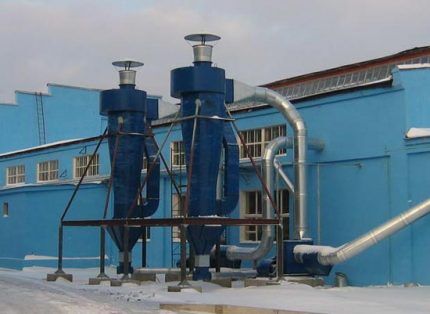
Removal of contaminants using systems of this type is carried out through special air ducts that have a large angle of inclination. This position helps prevent the appearance of so-called stagnation zones.
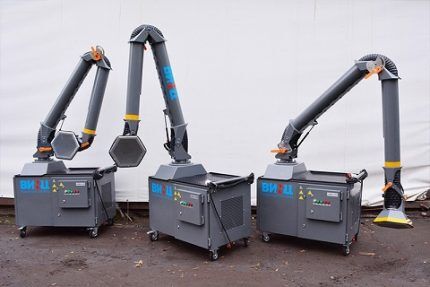
An indicator of the effectiveness of such a system is the degree of non-knocking out, i.e. the ratio of the amount of contaminants that were removed to the mass of harmful substances that did not enter the system.
There are two types of aspiration systems:
- modular systems — stationary device;
- monoblocks - mobile installations.
In addition, aspiration systems are classified according to pressure level:
- low-pressure — less than 7.5 kPa;
- medium pressure — 7.5-30 kPa;
- high-pressure - over 30 kPa.
The configuration of modular and monoblock type aspiration systems is different.

Monoblocks consist of the following elements:
- fan;
- separator;
- waste storage.
The separator is a filter for cleaning the air passing through the device. The waste storage facility can be either stationary, i.e. built into a monoblock, or removable.
Such a unit can be purchased ready-made and simply installed in a place suitable for performing aspiration procedures. At the same time, it is not difficult to connect them to existing centralized systems.
Modular systems are more difficult to install and are more expensive, but their use is much more effective than when using monoblock structures. Such systems are not standard; they are first designed taking into account specific conditions and tasks.
A number of factors are taken into account:
- characteristics of the production premises;
- features of the technological process;
- quality of the transported medium, etc.
This is usually a centralized system that consists of set of air ducts and suction block. For large enterprises, a system with not one, but two or more such blocks can be used.
The material of air ducts can be different, depending on the nature and amount of contaminants that are supposed to be transported through them.
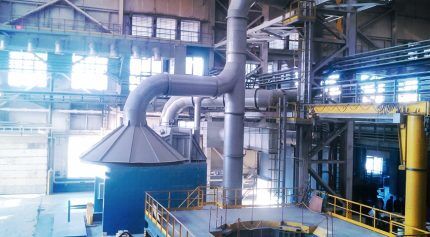
Structures made of ferrous metal are considered the most durable, but they are also the most expensive. In any case, individual sections of the air line are hermetically connected using bolted flanges.
Among the advantages of aspiration systems are:
- relative simplicity of design;
- compatibility with various types of production equipment;
- environmental safety;
- possibility of work automation;
- increasing the fire safety of the premises, etc.
The disadvantages of such installations include, first of all, increased energy costs, especially if the design is incorrect, as well as the low resistance of metal air ducts to wear. These points should be taken into account when choosing a suitable design.
Why design is necessary
To create a modular aspiration system, design the installation of the following elements:
- local suction;
- inclined air ducts;
- filter systems;
- high-pressure fan, etc.
Various models of devices can be used as local suction, for example, on-board suction, “umbrella”, “shelter” type structures and others. Air ducts are laid from the waste collection point to the point of transfer to the outside space.
The filtration system can involve both removing purified air masses from the room and returning them back after filtration to the point of intake.
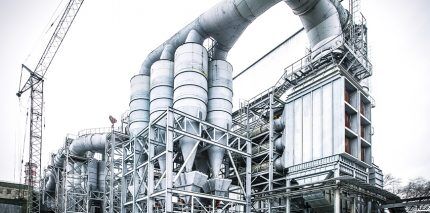
Before drawing up a project for an aspiration installation, it is necessary to conduct a technical examination of the condition of the object. At this stage, system deficiencies can be identified and eliminated. Existing ventilation and aspiration systems can be subjected to a similar check.
The efficiency of aspiration largely depends on the volume of air that passes through the air ducts per unit of time. The higher this indicator, the more expensive it is to install the structure, as well as the costs of its operation.
If you select the system components correctly, then costs, both initial and operating, can be significantly reduced.
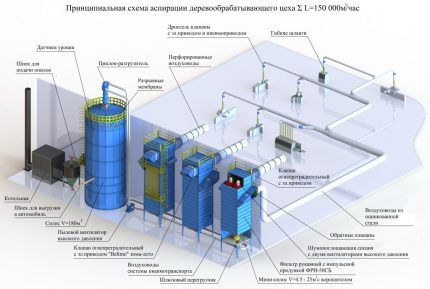
This includes choosing a suitable device for air suction, competent calculations for the distribution of supply air, etc. As a result, the load on the system will decrease, filters will require cleaning less often, fan life will increase, etc.
Some owners of industrial facilities follow the path of least resistance when selecting a cleaning system. They start from the parameters of a cyclone-type installation, simply informing the supplier of the conditions of its operation: air flow and the nature of contaminants.
As a result, they receive a device whose performance is selected according to tables without taking other parameters into account. Experienced designers say that this approach usually leads to increased costs and reduced equipment efficiency.
The cost of a cyclone installation is higher, the greater the volume of air that moves through it. If you optimize an existing air distribution system, you can select suction units and filters that will give the desired effect with less air consumption.
Such equipment will be cheaper, savings can amount to about a third of the total costs. That is why, before choosing equipment for an aspiration system, you should take care of technical expertise and invite experienced designers.
Features of installation of such structures
Since significant volumes of contaminants are transported through the air ducts of aspiration systems, such structures are subject to increased strength requirements, in contrast to supply ventilation systems.
For their manufacture, steel with a thickness of 1.2 to 5.0 mm is used, and for fittings it is recommended to use steel whose thickness is 1.0 mm greater than the duct material.
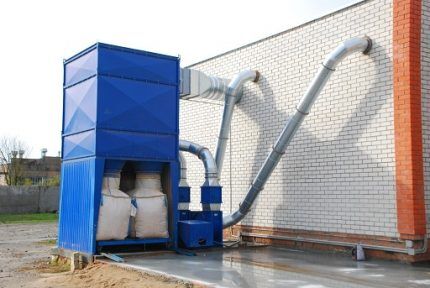
It is prohibited to secure the aspiration air ducts with clamps on the suspension. Only the use of clamps secured with brackets is allowed; in some cases, chains are used as fastening.
The maximum distance between brackets should be three meters for pipes with a diameter of more than 40 mm and four meters for structures with a diameter of 400 mm or less. These parameters will ensure sufficient structural strength and reduce the risk of air duct breakage during operation.
Another feature of aspiration air ducts is that they often have to be disassembled in order to clean the dirt accumulated on the walls. In addition, due to rapid wear and tear, individual elements must be replaced periodically.
For this reason, it is recommended to use quick-release connection elements for the installation of structures, rather than traditional flanges, which quickly become damaged due to frequent disassembly and reassembly.
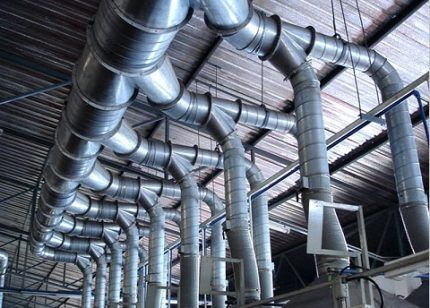
To regulate air flows, oblique dampers are used, which demonstrate less resistance to flow and better prevent the accumulation of contaminants. The use of control throttle valves in aspiration systems is not recommended. It is very important that the air ducts are positioned at the correct angle.
The position of the structure depends on the specified air flow rate, which is determined by the nature of the contaminants being removed. So, to ensure a speed of about 20 m/s, you need a slope of 60°, for a speed of 45 m/s - an angle of less than 60°, etc.
If the nature of the pollution makes it possible to predict the accumulation of sticky dust in the air ducts, then it is recommended that such industrial aspiration systems be initially designed with a view to the maximum speed of movement of air masses.

To facilitate the process of cleaning the structure, special liners made of film, paper and other suitable materials are inserted inside the air ducts. Conventional household and even some industrial fans are not suitable for aspiration systems, even if they have a fairly high performance.
We need devices with increased wear resistance that can operate for a long time under high load without interruption.
A common problem with low-efficiency aspiration systems is air loss. To prevent this phenomenon, experts recommend choose fans with some power reserve. Air losses in practice can reach 30% compared to calculated data.
The wrong choice of local suction can negatively affect the entire system. You cannot select such an element without taking into account the characteristics of the technological process.
In some cases, an “umbrella” type shelter will be effective; in others, a “showcase”, fume hood, cabin, etc. will be effective. This point must be agreed upon with the technologist at the specific production site.
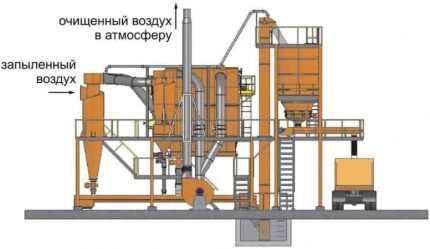
For rough air purification from dust, dust bags, non-partitioned dust chambers, bunkered flues, dry cyclones and other similar devices are used, depending on the nature of the dust.
Scrubbers are often used for medium cleaning, and fine cleaning is carried out using a set of tools, which may include a cyclone-type electrostatic precipitator and a bag filter, in some cases a high-pressure Venturi or other suitable units are used.
Why problems arise
Even if there is an aspiration system in the production area, it is necessary to periodically check the level of contaminants in the air. It happens that the system is operating normally, the filters are in order, but the air pollution remains too high.
The following may be the cause of deficiencies:
- dust accumulated in air ducts;
- low performance of the exhaust fan;
- too much air flow;
- insufficient influx of fresh air masses.
If a large amount of dust accumulates in the air ducts, this indicates that the design initially included too low speeds of movement of air masses. Another reason for this phenomenon is flaws in the configuration of the elements of the aspiration system.
The presence of excessively sharp turns, areas with a small slope, the lack of a sufficient number of cleaning hatches, etc. may hinder the timely removal of dust particles from the system.
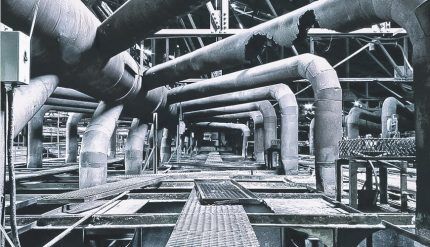
Incorrect installation or errors can cause too much air loss in the system, resulting in an overall decrease in unit performance. Air leakage can also occur as a result of improper operation of the filtration system. For this reason, when making calculations, it is recommended to include a sufficient percentage for such losses.
If sufficient air is flowing through the system and the system still does not perform as expected, the design of the local suction-shelter may need to be reconsidered.
It should be located so as to collect the maximum amount of contaminants, preventing them from entering the room air. This structure is designed in such a way that it does not interfere with the work and movement of personnel.

If a sufficient amount of fresh air does not enter the room, there will not be enough air to operate the aspiration system. To compensate for the increased efficiency of air exchange, a supply air duct is installed in the production area. ventilation with recovery.
In hot shops, heating the air coming from outside is not necessary; it is enough to make an opening in the wall and close it with a damper.
Conclusions and useful video on the topic
Here is an overview of the unpacking and installation of the RIKON DC3000 mobile aspiration system for the wood industry:
This video demonstrates a stationary aspiration system used in furniture production:
Aspiration systems are a modern and reliable way to purify the air in industrial premises from hazardous pollutants.If the structure is correctly designed and installed without errors, it will demonstrate high efficiency at minimal cost.
Do you have anything to add or have any questions about aspiration systems? Please leave comments on the post. The contact form is located in the lower block.




I learned from my own experience that aspiration systems are a very difficult system to calculate and design. The company I worked for was expanding production. We built a carpentry shop on our own. Having a higher education in construction, I tried to design an aspiration system myself to remove dust and small waste from machine tools. Not so. I realized that there are too many nuances. Reference books and manuals were not enough. Special knowledge is needed so as not to redo the entire system again later.
Oleg, of course, they write all sorts of things in the comments, but why write so waterily about something that is already obvious? And those who would like to try it themselves, and then saw your comment, could at least add a little specificity. What kind of knowledge is specific, and what are the most important nuances to take into account? What were the first problems you encountered? More, more specific.